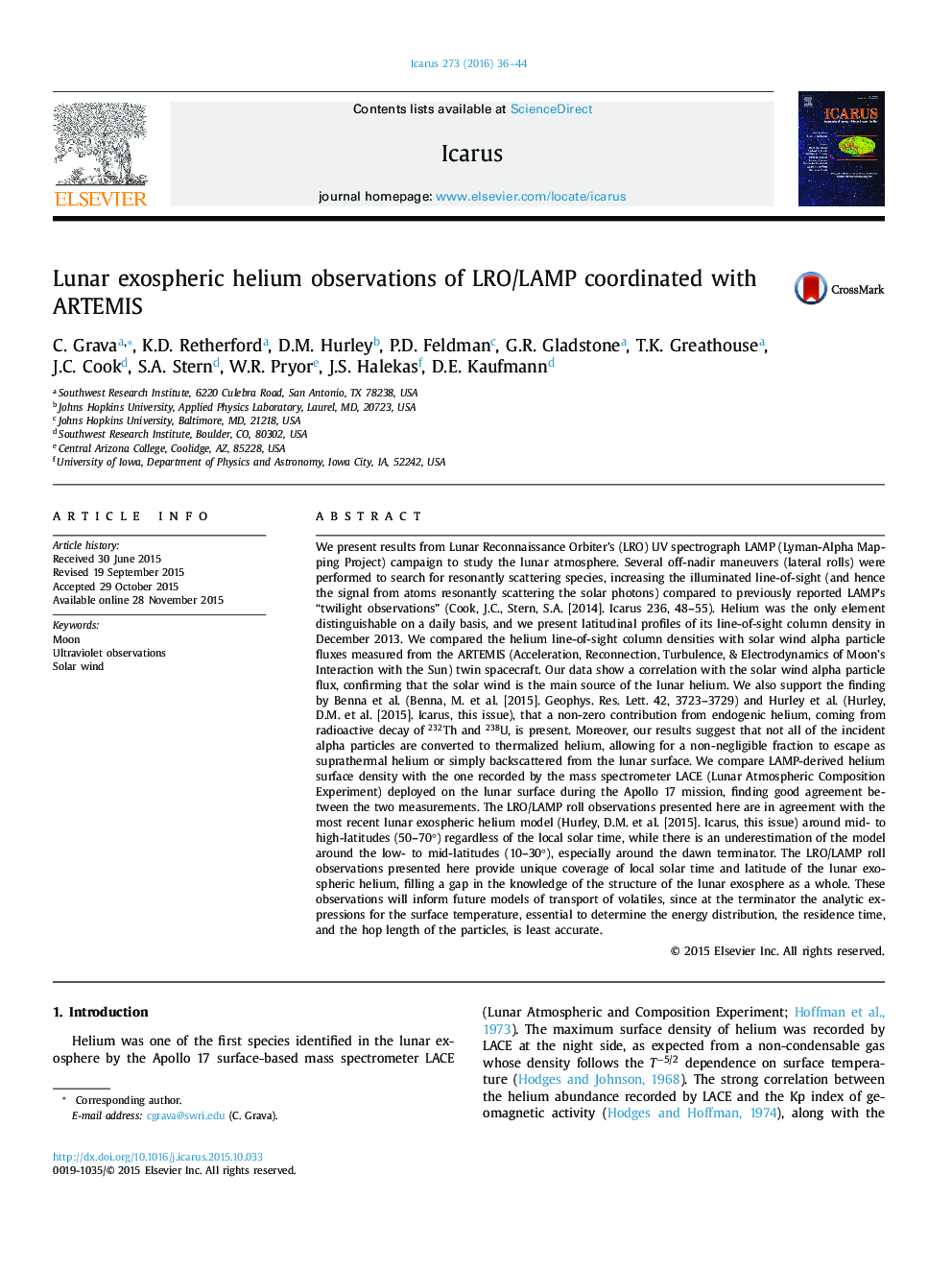| کد مقاله | کد نشریه | سال انتشار | مقاله انگلیسی | نسخه تمام متن |
|---|---|---|---|---|
| 8135066 | 1523517 | 2016 | 9 صفحه PDF | دانلود رایگان |
عنوان انگلیسی مقاله ISI
Lunar exospheric helium observations of LRO/LAMP coordinated with ARTEMIS
دانلود مقاله + سفارش ترجمه
دانلود مقاله ISI انگلیسی
رایگان برای ایرانیان
کلمات کلیدی
موضوعات مرتبط
مهندسی و علوم پایه
علوم زمین و سیارات
علوم فضا و نجوم
پیش نمایش صفحه اول مقاله

چکیده انگلیسی
We present results from Lunar Reconnaissance Orbiter's (LRO) UV spectrograph LAMP (Lyman-Alpha Mapping Project) campaign to study the lunar atmosphere. Several off-nadir maneuvers (lateral rolls) were performed to search for resonantly scattering species, increasing the illuminated line-of-sight (and hence the signal from atoms resonantly scattering the solar photons) compared to previously reported LAMP's “twilight observations” (Cook, J.C., Stern, S.A. [2014]. Icarus 236, 48-55). Helium was the only element distinguishable on a daily basis, and we present latitudinal profiles of its line-of-sight column density in December 2013. We compared the helium line-of-sight column densities with solar wind alpha particle fluxes measured from the ARTEMIS (Acceleration, Reconnection, Turbulence, & Electrodynamics of Moon's Interaction with the Sun) twin spacecraft. Our data show a correlation with the solar wind alpha particle flux, confirming that the solar wind is the main source of the lunar helium. We also support the finding by Benna et al. (Benna, M. et al. [2015]. Geophys. Res. Lett. 42, 3723-3729) and Hurley et al. (Hurley, D.M. et al. [2015]. Icarus, this issue), that a non-zero contribution from endogenic helium, coming from radioactive decay of 232Th and 238U, is present. Moreover, our results suggest that not all of the incident alpha particles are converted to thermalized helium, allowing for a non-negligible fraction to escape as suprathermal helium or simply backscattered from the lunar surface. We compare LAMP-derived helium surface density with the one recorded by the mass spectrometer LACE (Lunar Atmospheric Composition Experiment) deployed on the lunar surface during the Apollo 17 mission, finding good agreement between the two measurements. The LRO/LAMP roll observations presented here are in agreement with the most recent lunar exospheric helium model (Hurley, D.M. et al. [2015]. Icarus, this issue) around mid- to high-latitudes (50-70°) regardless of the local solar time, while there is an underestimation of the model around the low- to mid-latitudes (10-30°), especially around the dawn terminator. The LRO/LAMP roll observations presented here provide unique coverage of local solar time and latitude of the lunar exospheric helium, filling a gap in the knowledge of the structure of the lunar exosphere as a whole. These observations will inform future models of transport of volatiles, since at the terminator the analytic expressions for the surface temperature, essential to determine the energy distribution, the residence time, and the hop length of the particles, is least accurate.
ناشر
Database: Elsevier - ScienceDirect (ساینس دایرکت)
Journal: Icarus - Volume 273, 15 July 2016, Pages 36-44
Journal: Icarus - Volume 273, 15 July 2016, Pages 36-44
نویسندگان
C. Grava, K.D. Retherford, D.M. Hurley, P.D. Feldman, G.R. Gladstone, T.K. Greathouse, J.C. Cook, S.A. Stern, W.R. Pryor, J.S. Halekas, D.E. Kaufmann,